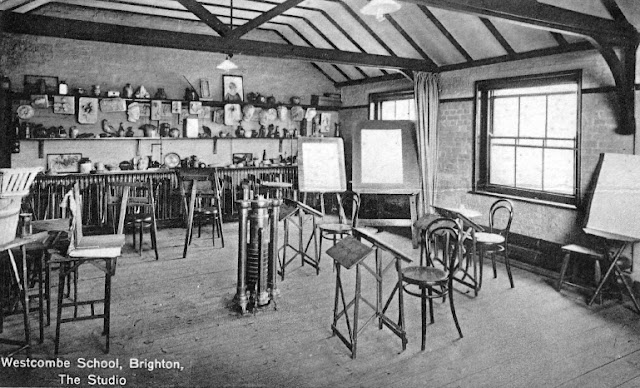 |
| copyright © Royal Pavilion &
Museums, Brighton & Hove
1909 Advert |
This was the name of an exclusive Girls’ School that existed for almost 100 years. The 1851 census records it at 5 / 6 Dyke Road, Hove, with Louisa E. Chapman, aged 36, in charge. There were fifteen girl pupils, three governesses and three servants.
An
impressive advertisement appeared in the Hove
Year Book 1907 stating
that the Misses Stevens received from 30 to 40 young ladies as
resident pupils. ‘It is their aim to unite the comforts and
sympathies of home life with a thorough and systematic education of
the mental and physical facilities.’ Westcombe received the
recognition of the Board of Education, and there was a resident staff
of six mistresses with university qualifications and diplomas, as
well as visiting professors. Westcombe had notched up many successes
at Girton and elsewhere, and was ‘one of the best educational
establishments for the daughters of gentlemen.’
 |
| copyright © Royal Pavilion &
Museums, Brighton & Hove
1909 Advert |
The school was obviously doing well because in 1911 Hove Council approved plans by H. W. Sanders for additional rooms in the roof, while in 1914 Messrs Norman drew up plans for yet more rooms.
Jean Whitcher was at Westcombe in
the late 1920s and she was fortunate to have been accepted. This was
because her father had started his career as a qualified engineer,
and inventor, with particular reference to the gas industry. He had
done well, and become wealthy, as well as being a passionate
sportsman, later being chairman of Brighton & Hove Albion
Football Club. But Mr Whitcher did not match the popular notion of a
‘gentleman’. There was quite a discussion among those in charge
of the school, as to whether or not young Jean should be allowed to
join the company of young ladies because her father was regarded as
being in ‘trade’. At length it was decided that perhaps they
could overlook this unfortunate fact, no doubt thinking of the fees
involved. Jean duly took up residence. She thoroughly enjoyed her
time at Westcombe, saying it was tremendous fun, just like the novels
of Angela Brazil, and did she not remember mid-night feasts in the
Dorm and an illicit visit to a Brighton cinema? Strangely enough,
Jean’s son and daughter were less enamoured of the boarding school
experience.
 |
| copyright © J Middleton |
Westcombe lasted until the 1940s.
Sources
Census returns
Encyclopaedia of Hove and Portslade
Hove Council Minute Books
Hove Year Book 1907
Royal Pavilion & Museums, Brighton & Hove
copyright © J.Middleton 2022
page
layout by D. Sharp